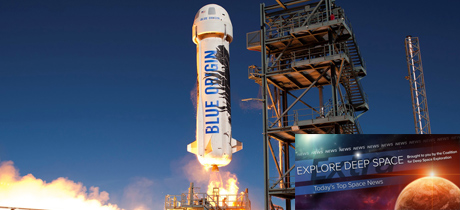In Today’s Deep Space Extra… Perseverance rover taking lessons learned from Curiosity. Concern grows over the orbital re-entry of the Chinese Long March 5B rocket first stage used to launch the core module of China’s new space station.
Space Science
Radiation resistance is baked into the Perseverance Mars rover. Here’s why that’s important.
Space.com (5/6): From time to time, the Curiosity rover has gone into “safe mode” to deal with glitches and software problems since it landed on Mars in August 2012. But each time, the mission has recovered to continue its epic climb up a Martian mountain in search of habitable environments. All those “lessons learned” from safe mode incidents are now embedded into the new Perseverance rover, the more powerful cousin of Curiosity that started rolling on Mars on March 5.
A rare glimpse of a star before it went supernova defies expectations
Sciencenews.org (5/5): Observed with telescopes about 2.6 years before it exploded, the star SN 2019yvr’s demise was eye opening, detonating in an unexpected hydrogen free environment, according to an assessment led by a Northwestern University astronomer. It’s a mystery how much hydrogen was shred before the detonation, a clue that star evolution still leaves something to be understood.
Stars made of antimatter could exist in the Milky Way
Space.com (5/5): An ongoing assessment hints at the prospect the 100 billion stars in the Milky Way galaxy include 14 composed of antimatter. The Alpha Magnetic Spectrometer (AMS) aboard the International Space Station (ISS) and NASA’s Fermi gamma ray telescope have contributed to the search for the rare objects that emit bright gamma rays.
NASA’s new fleet of satellites will offer insights into the wild cards of climate change
Sciencemag.org (5/5): A new generation of NASA Earth science satellites is emerging, with an increase of funding for studies of climate change gaining urgency under the Biden administration. Four missions that could launch as soon as 2028 as part of an Earth system observatory will focus on assessments of clouds and aerosols in the atmosphere, as well as temperature and chemistry.
Other News
China’s huge rocket booster falling from space highlights orbital debris problem
Space.com (5/5): Mounting orbital space debris is an issue for the pending economic development of low Earth orbit. An example of the issue is the first stage of China’s Long March 5B that launched Tianhe, the core module for the Asian nation’s new space station, on April 28. The rocket body could make an uncontrolled re-entry into the Earth’s atmosphere as soon as Sunday, with enough mass to reach the surface with a destructive force. It’s but one of hundreds of aging rocket bodies circling the Earth.
Blue Origin puts its first passenger seat on suborbital spaceship up for charity auction
Geekwire.com (5/5): Blue Origin plans to launch its first six-person New Shepard suborbital flight with passengers from West Texas on July 20. On Wednesday, Blue Origin announced it was seeking bids for one of the seats, a call that coincided with the 60th anniversary of the first U.S. human spaceflight, that of the late NASA Mercury astronaut Alan Shepard, for whom the rocket is named. The first round of bids is due May 19, and there some physical requirements.

